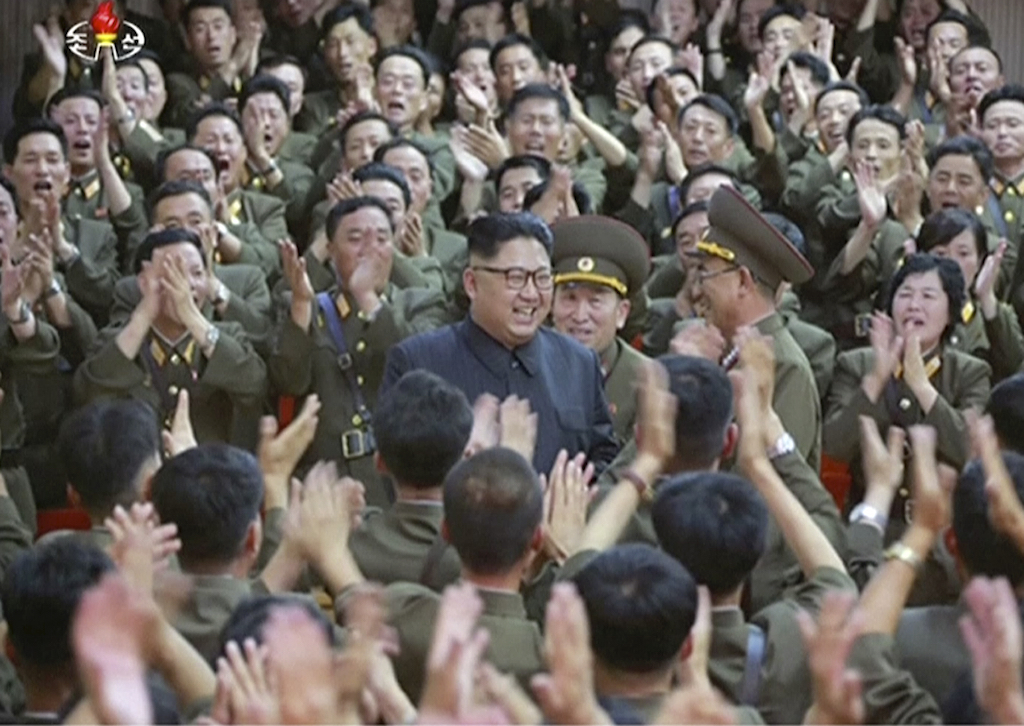Don’t Believe the Alarmist Propaganda About North Korea
The U.S. national security establishment has inflated the threat of the North Korean nuclear program. A still image of North Korean leader Kim Jong Un broadcast in a news bulletin by North Korea's KRT on Tuesday. (KRT via AP video)
A still image of North Korean leader Kim Jong Un broadcast in a news bulletin by North Korea's KRT on Tuesday. (KRT via AP video)
Never underestimate the ability of the national security establishment to believe its own alarmist propaganda—remember those establishment members believed in the fable of Saddam Hussein’s weapons. Among the specters currently haunting our defense policymakers is the idea that Kim Jong Un has instituted a “dead hand” for his nuclear arsenal. This means that if the portly North Korean leader is suddenly obliterated in a drone strike or by some other means of assassination, his nuclear arsenal will automatically and immediately launch, speeding unstoppably toward pre-assigned targets. “That’s what keeps people awake at night,” one well-connected former Pentagon official informed me.
Amazingly, this assessment carries weight despite the fact that the entire North Korean long-range missile arsenal, what there is of it, is powered by a liquid-fuelled rocket engine, the RD-250, developed in Russia in 1965 and first built in the Ukraine. Come the downfall of the Soviet Union and the decay of its once-mighty military-industrial base, some of these motors were surreptitiously acquired by the North Koreans, mostly in the early 1990s.
Given that the fall of the USSR meant the end of cheap Russian oil imports, devastating the North Korean economy and leading to the devastating famines of the 1990s (no fertilizer), North Korea most definitely could not afford to buy more than a limited number of these ancient motors. Given that there is no sign of Kim Jong Un’s engineers coming up with a homegrown rocket engine, the country cannot have enough motors to supply a missile production line. It likely only has enough for the tests that generate so much excitement on this side of the Pacific.
The history of threat inflation has many high points. Among the unlikely scenarios that have powered media alarms and boosted defense budgets over the years, we should count such standouts as the notion that Saddam possessed an arsenal of weapons of mass destruction—nuclear and otherwise—and the Soviet “first strike” threat, when all U.S. intercontinental ballistic missiles would be disabled simultaneously by infallibly accurate Soviet missiles, leaving no option but surrender,
Coincidentally or not, North Korea made it to the front rank of strategic threats in time to share it with Saddam’s Iraq. Testifying before the Senate Armed Services Committee in February 2003, (just as U.S. forces were assembling for their fatal foray into Iraq), then-CIA Director George Tenet stated “we are on high alert” due to the “proliferation of nuclear and chemical and biological weapons, in particular in Iraq and North Korea.” He warned that North Korea would soon be able to strike the U.S. mainland.
Iraq may have subsequently disappeared as any kind of threat, but North Korea is still going strong, recently hitting overdrive with the July 28 launch of the Hwasong-14 missile that ignited paroxysms of hysteria from the White House to The Washington Post and beyond. (As the Post put it, “an evolving North Korean military threat … appears to be advancing far more rapidly than many experts had predicted.”) However, news of what happened to the missile as it plunged toward the Sea of Japan did not make it even close to the headlines. Footage from a Japanese NHK World TV weather camera clearly shows the final stage of the missile breaking up.
Any kind of re-entry vehicle has a heat shield, without which it burns and breaks up as it plows through the atmosphere. The Hwasong’s fate means either that the Koreans don’t know how to make a working heat shield, or that they haven’t bothered. A former Pentagon weapons designer recently reminded me that the dazzling aerobatics performed by the latest fighter planes at the biennial Paris Air Show are only possible because the planes have been stripped of weapons and ammunition, while carrying the minimum amount of fuel. Thus, their displays are irrelevant as far as combat is concerned.
The North Koreans appear to have adopted the same approach, by perhaps dispensing with a heat shield and also by skipping the task of building a warhead big enough to contain their bulky nuclear weapon. (The Post dutifully cited a Defense Intelligence Agency report that Kim’s scientists had successfully miniaturized their bomb, an extraordinarily unlikely development.) Instead, the second stage of the missile has been slimmed, lightened and shaped to achieve the maximum possible altitude, heading straight up before heading almost straight down again, landing a mere 560 miles or so from its launch point.
There was no need to endow it with the capability to reach the U.S. mainland, or even Alaska, because an army of threat-inflators in government offices and newsrooms across Washington stood ready and willing to do just that. Eagerly, they seized on the presumption that a missile that could fly so high (almost 2,500 miles) must necessarily be capable of flying all the way across the Pacific. Perhaps the missile could do just that—but only if it were a militarily useless “Paris Air Show” version. It also would likely break apart on re-entry.
More sober commentators, in the form of MIT’s Ted Postol and two German academics, examined published evidence and reported in the Bulletin of the Atomic Scientists that the recent Korean test missiles had carried unrealistically light payloads. If they had to carry weight equivalent to that of the Koreans’ bulky nukes, they would never have flown so high, nor could they conceivably reach the U.S. mainland.
The North Koreans are often credited with steadily improving their missiles’ accuracy. But since they do not tell us what they are aiming at in their tests, it is hard to see how we could know whether they hit the target or not.
Postol and his fellow experts write respectfully of the quality of the Soviet rocket engine designs and say that the Koreans’ “skill and ingenuity in using Soviet rocket motor components … is not good news in the long run.” But without an inventory of rocket motors large enough to start a production line, and without a missile capable of reaching the U.S. with an actual weapon on board, Kim Jong Un likely will be confined to running “Paris Air Show”-type tests a few times a year. Maybe that’s all he needs.
Your support is crucial...As we navigate an uncertain 2025, with a new administration questioning press freedoms, the risks are clear: our ability to report freely is under threat.
Your tax-deductible donation enables us to dig deeper, delivering fearless investigative reporting and analysis that exposes the reality beneath the headlines — without compromise.
Now is the time to take action. Stand with our courageous journalists. Donate today to protect a free press, uphold democracy and uncover the stories that need to be told.





You need to be a supporter to comment.
There are currently no responses to this article.
Be the first to respond.